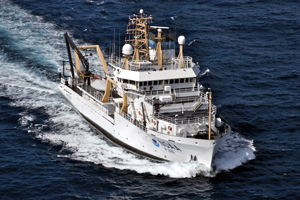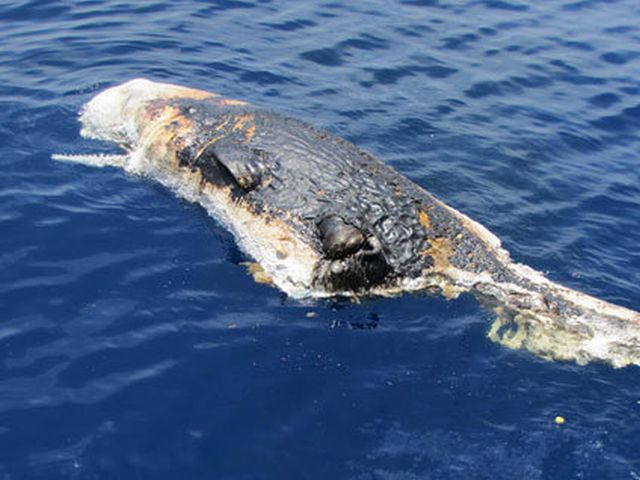- NOAA Conducts Tests to Determine Fate of Whale
- Found Dead in Gulf of Mexico
- Whale Not Found in Oiled Water, but Cause
of Death Unknown
- 6-17-10
-

-
- NOAA Ship Pisces.
- High resolution (Credit: NOAA)
-
- On Tuesday, June 15, the NOAA Ship Piscesreported a dead
sperm whale floating 77 miles due south of the Deepwater Horizon spill
site. NOAA is currently in the process of conducting thorough testing to
determine the circumstances surrounding the mammal's death, as well as
collect information about its life. This is the first dead whale reported
since BP's rig exploded on April 20 It was not found in oiled waters; however,
its location of death is unknown.
-
- As soon as the whale was sighted, Pisces Field Party
Chief Paul Felts called the marine mammal hotline to report the finding
to the Wildlife Branch of the Unified Command and NOAA's marine mammal
experts.
-
- Based on the estimated size of the whale, scientists
believe it is a sub-adult. Its condition suggests it may have been dead
for between several days to more than a week. Although it was not found
in oiled water, NOAA marine mammal experts are using hindcasting analysis
to look into the location from which the whale carcass may have drifted.
-
- While it is impossible to confirm whether exposure to
oil was the cause of death, NOAA is reviewing whether factors such as ship
strikes and entanglement can be eliminated. Samples collected from this
carcass will be stored under proper protocols and handed off when the Pisces
comes to port on July 2, or possibly if another boat is sent to meet the
Pisces. Full analysis of the samples will take several weeks.
-
- In accordance with the Wildlife Branch protocols, NOAA's
Southeast Regional Marine Mammal Stranding Coordinator Blair Mase requested
that the NOAA field crew take photographs of the approximately 25-foot
whale, collect skin swab for oil analysis, collect blubber and skin samples
for analysis, and measure its height in the water. Although the whale is
very decomposed, the photographs and samples will help scientists better
understand how long it has been dead. The blubber and skin samples will
be used for genetic analysis and to determine the sex of the animal. Measurements
of the whale floating in the water will be used to determine how far and
how fast it might have floated from where it died. The carcass has been
marked so that aerial reconnaissance teams will be able to identify the
individual and will not report it as a new mortality.
-
- NOAA and the Unified Command Wildlife Branch have had
numerous reports of sperm whales seen swimming in the oil, but this is
the first confirmed report of a dead whale since the BP oil spill began.
NOAA remains concerned about sperm whales, which are the only endangered
resident cetaceans in the upper Gulf of Mexico. Sperm whales spend most
of their time in the upper Gulf offshore area, live at depth in areas where
subsurface dispersants and oil are present, and feed on deepwater squid,
which may also be impacted by the oil and dispersants.
-
- The NOAA Ship Gordon Gunter sailed yesterday for a multi-week
cruise to do photo identification, assessments, tagging, biopsies, and
prey-density studies for sperm whales and Bryde's whales. Nearshore and
offshore response efforts are continuing, and include investigations to
determine cause of death or illness for dolphins that have stranded and
aerial surveys for cetaceans throughout the area. The information gained
from these efforts will help assess the impacts of this event on cetaceans
in the Gulf of Mexico.
- Another story on this outrage... http://www.nytimes.com/2010/06/18/us/18whale.html?_r=1
|

